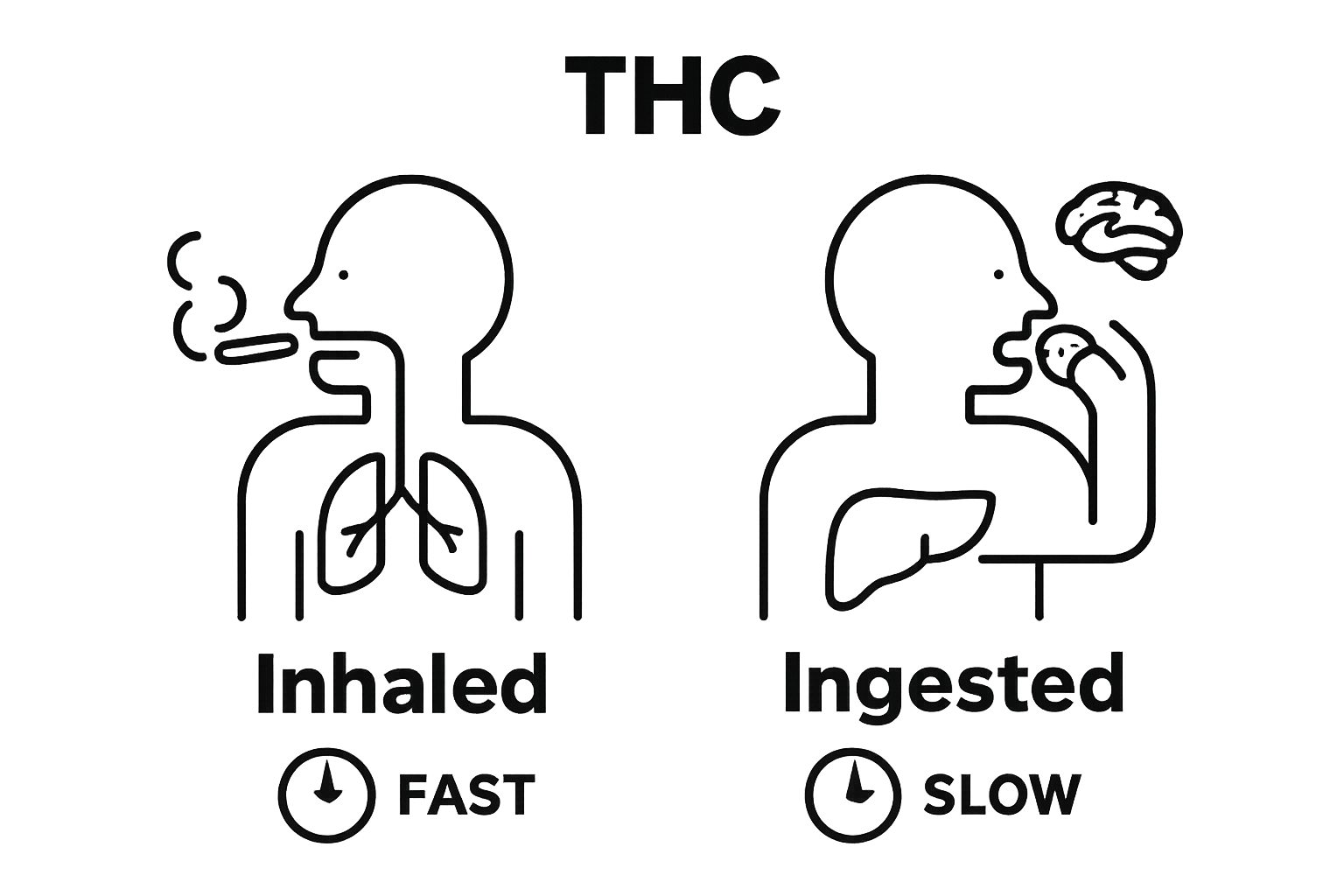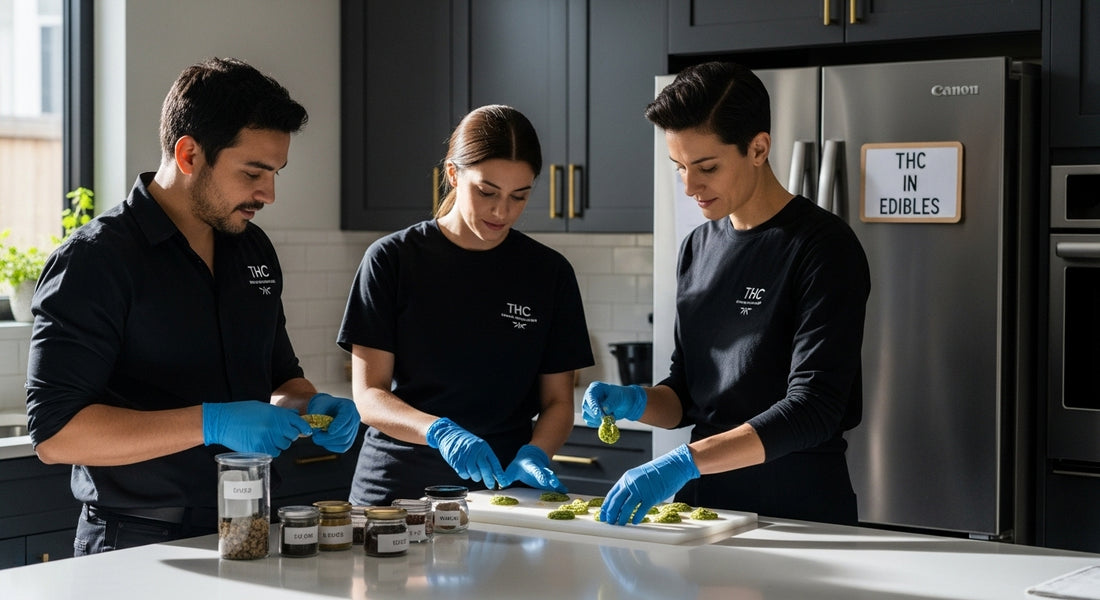Edible cannabis products are everywhere, changing how people think about consuming THC. Most imagine that eating THC just gives a delayed high, but the science tells a much deeper story. When you eat THC, your liver transforms it into 11-hydroxy-THC, which is even more potent and long-lasting than smoked cannabis—effects can last up to 8 hours. That single metabolic twist is why the edible experience hits harder and lingers so much longer than anyone expects.
Table of Contents
- What Is THC And How Does It Affect Edibles?
- The Importance Of THC In The Cannabis Experience
- How THC Interacts With The Body’s Endocannabinoid System
- Factors Affecting THC Potency In Edibles
- Real-World Applications Of THC In Edible Products
Quick Summary
| Takeaway | Explanation |
|---|---|
| THC is a complex cannabinoid | THC’s interaction with the endocannabinoid system determines its psychoactive effects and overall impact on the body. |
| Metabolism alters THC potency | Oral consumption leads to the conversion of THC into a stronger metabolite, impacting both onset and duration of effects. |
| Individual factors influence experience | Each person’s biochemistry affects THC absorption, resulting in varied experiences and responses to edibles. |
| Long-lasting effects from edibles | Edibles provide prolonged psychoactive experiences lasting 6-8 hours compared to inhaled methods. |
| Therapeutic potential of THC | THC edibles can offer targeted relief for chronic conditions, enhancing wellness strategies through precise dosage control. |
What is THC and How Does it Affect Edibles?
Tetrahydrocannabinol (THC) represents the primary psychoactive compound found in cannabis that creates the characteristic “high” associated with marijuana consumption. When THC enters the body through edibles, its interaction with the human system becomes remarkably complex and distinct from other consumption methods.
The Chemical Composition of THC
THC is a cannabinoid molecule with a unique chemical structure that directly interfaces with the human endocannabinoid system. Unlike inhaled cannabis, which enters the bloodstream rapidly through lung absorption, edible THC undergoes significant metabolic transformation. Scientific research from the National Institutes of Health demonstrates that when consumed orally, THC is processed by the liver and converted into 11-hydroxy-THC, a metabolite that demonstrates increased potency and longer-lasting effects.
Metabolic Processing and Effects
The metabolic journey of THC in edibles creates a distinctly different experience compared to smoking or vaping. When you consume an edible, the THC must first pass through the digestive system and liver before entering the bloodstream. This process triggers a slower onset of effects but produces a more intense and prolonged psychoactive experience. Effects can take anywhere from 30 minutes to two hours to manifest and can last significantly longer than inhaled cannabis.

Key characteristics of THC in edibles include:
- Longer duration of psychoactive effects (potentially 6-8 hours)
- More intense body-centered experience
- Slower absorption rate compared to inhalation methods
Understanding these nuanced interactions helps consumers make informed decisions about edible consumption.
The following table compares the effects, onset time, and duration of THC when consumed via edibles versus inhalation, helping clarify the key experiential differences between these two popular consumption methods.
| Consumption Method | Onset Time | Duration of Effects | Metabolic Pathway | Characteristics |
|---|---|---|---|---|
| Edibles | 30-120 minutes | 6-8 hours | Liver (to 11-hydroxy-THC) | More intense, longer-lasting, body-centered high |
| Inhalation (Smoking/Vaping) | Seconds to minutes | 2-3 hours | Lungs (direct to bloodstream) | Quick onset, more controllable, shorter duration |
If you want to read more about cannabis edible strategies, our comprehensive guide offers additional insights into responsible usage and dosage considerations.
The Importance of THC in the Cannabis Experience
THC plays a fundamental role in defining the psychological and physiological experience of cannabis consumption, serving as the primary mechanism through which users experience altered perception, mood modification, and potential therapeutic benefits. Understanding its significance goes beyond simple recreational use, encompassing complex interactions within the human body.
Neurological Impact and Receptor Interaction
The human endocannabinoid system contains specialized receptors that THC directly engages, particularly CB1 receptors located in the brain and central nervous system. Research from Johns Hopkins University demonstrates that these interactions trigger significant neurological responses, influencing everything from pain perception to emotional regulation. THC essentially acts as a molecular key, unlocking neurological pathways that modulate mood, appetite, and sensory experiences.
Physiological and Psychological Effects
THC’s importance extends far beyond simple intoxication. Its complex interactions produce a multifaceted experience that can include:
- Euphoric mental states
- Potential pain management
- Reduced anxiety for some individuals
- Altered sensory perception
- Potential anti inflammatory responses
These effects vary dramatically based on individual physiology, dosage, and consumption method. For consumers interested in understanding precise dosing strategies, our comprehensive edibles guide offers detailed insights into responsible consumption.
The nuanced role of THC underscores its significance not just as a recreational compound, but as a complex molecular agent with profound implications for human neurochemistry and potential therapeutic applications.
How THC Interacts with the Body’s Endocannabinoid System
The endocannabinoid system represents a complex cellular communication network that plays a critical role in regulating numerous physiological processes. THC interacts with this system through a sophisticated mechanism of receptor engagement, fundamentally altering how the body processes signals and maintains internal balance.
Receptor Binding and Molecular Interaction
THC primarily targets two primary cannabinoid receptors: CB1 and CB2. CB1 receptors are predominantly located in the brain and central nervous system, while CB2 receptors are more prevalent in peripheral tissues and immune cells. Research published in PubMed demonstrates that THC’s molecular structure allows it to bind directly with these receptors, triggering a cascade of neurochemical responses that influence mood, pain perception, and cognitive function.
Systemic Effects and Neurological Signaling
When THC enters the body, it disrupts normal neurotransmitter signaling by mimicking the body’s natural endocannabinoids. This interaction produces a range of physiological effects that extend beyond simple psychoactive experiences:
- Modulation of neurotransmitter release
- Alteration of synaptic communication
- Potential regulation of inflammatory responses
- Modification of pain signal processing
- Influence on appetite and metabolic functions
These complex interactions highlight the intricate ways THC interfaces with the human body. For consumers seeking deeper understanding of cannabis consumption methods, our comprehensive edibles guide provides additional insights into responsible usage and potential effects.
Understanding the endocannabinoid system’s response to THC represents a critical frontier in comprehending how cannabis interacts with human physiology, offering promising avenues for both recreational and potential therapeutic applications.
Factors Affecting THC Potency in Edibles
Understanding THC potency in edibles requires a nuanced exploration of multiple interconnected variables that influence the overall cannabis experience. These factors extend far beyond simple THC concentration, encompassing complex physiological and environmental interactions that can dramatically alter an individual’s response.
Individual Physiological Variations
Each person’s unique biological makeup significantly impacts how THC is processed and experienced. Metabolism, body weight, tolerance levels, and individual endocannabinoid system sensitivity create substantial variability in THC absorption and effect intensity. Research from the Washington State Liquor and Cannabis Board highlights that personal biochemistry plays a critical role in determining how an individual responds to edible cannabis products.
Product Composition and Consumption Factors
Multiple elements within the edible itself contribute to THC potency and experience:
- Cannabinoid profile and concentration
- Terpene interaction and synergy
- Metabolic processing method
- Product form and ingredients
- Stomach contents during consumption
The interaction between these variables creates a complex landscape of potential experiences. For consumers interested in understanding different cannabis product formats, our guide to infusion beverages offers additional insights into product diversity.
Consumers should approach edible THC consumption with careful consideration, recognizing that potency is not a uniform experience but a highly personalized interaction between the product and individual physiology.
This table organizes the key factors mentioned in the article that influence the potency and individual experience of THC in edibles, enabling readers to quickly identify which variables may affect their results.
| Factor | Description |
|---|---|
| Metabolism | Individual metabolic rates affect THC processing |
| Body Weight | Total body mass can impact absorption and potency |
| Tolerance | Regular users may experience reduced effects |
| Endocannabinoid Sensitivity | Personal receptor response alters experience |
| Cannabinoid Profile | Varying THC, CBD, and other compounds in product |
| Terpene Interaction | Aromatic compounds modify effects and synergy |
| Product Form & Ingredients | Type of edible and recipe influence absorption |
| Stomach Contents | Food in stomach alters absorption rate and intensity |
Real-World Applications of THC in Edible Products
THC edibles have evolved far beyond recreational consumption, emerging as a sophisticated product category with diverse applications across medical, wellness, and lifestyle domains. These innovative products leverage THC’s unique molecular properties to address complex human physiological and psychological needs.
Medical and Therapeutic Potential
In medical contexts, THC edibles offer nuanced therapeutic interventions for patients experiencing chronic conditions. They provide controlled, sustained cannabinoid delivery, making them particularly valuable for managing persistent symptoms. Research from Johns Hopkins Medicine demonstrates that carefully formulated edibles can offer targeted relief for conditions involving pain management, neurological disorders, and inflammatory responses.
Wellness and Lifestyle Applications
Beyond medical use, THC edibles have integrated into broader wellness strategies, offering alternative approaches to stress management, sleep regulation, and mood enhancement. These products present unique advantages:
- Precise dosage control
- Longer duration of effect
- Reduced respiratory impact compared to smoking
- Discreet consumption method
- Potentially more consistent physiological response
For consumers interested in exploring diverse cannabis product formats, our guide to infusion beverages provides comprehensive insights into modern consumption techniques.
The continuous evolution of THC edible products reflects a sophisticated understanding of cannabinoid interactions, representing a significant advancement in how humans can strategically leverage cannabis for improved health and wellness outcomes.

Discover Edibles Made for Real Results
Are you searching for THC edibles that provide reliable potency and a consistent experience every time? The article highlighted real concerns about unpredictable effects and the complexities of THC metabolism in edibles. At Avondale Apothecary, we hear you. Many people struggle to find cannabis edibles they can trust because of unpredictable onset times and potency. We use thorough third-party testing and clear Certificates of Analysis so you know exactly what each product delivers. Shop with peace of mind and enjoy a body-centered high that matches your expectations.

Why take chances with your next edible? Visit Avondale Apothecary for a curated collection of high-quality cannabis edibles and discover the difference that transparency and precision can make. Ready to try something new? Browse our selection and learn more about product options in our guide to cannabis edibles. Your next reliable THC experience is just a click away.
Frequently Asked Questions
What is THC and how does it affect edibles?
THC (Tetrahydrocannabinol) is the primary psychoactive compound in cannabis, responsible for the ‘high’ associated with marijuana. In edibles, THC undergoes metabolic transformation in the liver, converting into 11-hydroxy-THC, which results in more intense and longer-lasting effects compared to other consumption methods.
How does the consumption method affect the experience of THC in edibles?
Consuming THC through edibles results in a slower onset of effects, typically taking 30 minutes to 2 hours to feel the impact. However, the effects can last significantly longer—up to 6-8 hours—creating a distinct experience compared to smoking or vaping.
What factors influence the potency of THC in edibles?
Several factors affect THC potency, including individual metabolism, body weight, tolerance, and the specific composition of the edible (such as cannabinoid profile, terpenes, and ingredients). These elements contribute to how THC is absorbed and experienced.
What are the therapeutic applications of THC in edibles?
THC edibles provide controlled, sustained cannabinoid delivery, making them useful for managing chronic conditions, pain, anxiety, and inflammation. They can also be used for wellness purposes, such as stress management and sleep regulation.

